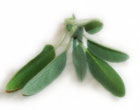Recipe
GOODNESS
 Sage:
This delightful herb is a key player in some terrific recipes, but it is also a great purifier, fighting both bacteria and viruses. It is a powerful anti-inflammatory, and is used by many to ease the symptoms of arthritis. It also helps to lower blood pressure and control blood sugar. Like rosemary, it has been used since ancient times as a memory enhancer. Although it is just fine in foods, you should avoid excessive quantities of sage if you are pregnant.
Sage:
This delightful herb is a key player in some terrific recipes, but it is also a great purifier, fighting both bacteria and viruses. It is a powerful anti-inflammatory, and is used by many to ease the symptoms of arthritis. It also helps to lower blood pressure and control blood sugar. Like rosemary, it has been used since ancient times as a memory enhancer. Although it is just fine in foods, you should avoid excessive quantities of sage if you are pregnant. |
ADVERTISEMENT
Help • Site Map • About Us • Contact Us • Privacy Policy • Press Center
Spice Plan™ Copyright © 2009 by Scott Charles Anderson. All rights reserved.